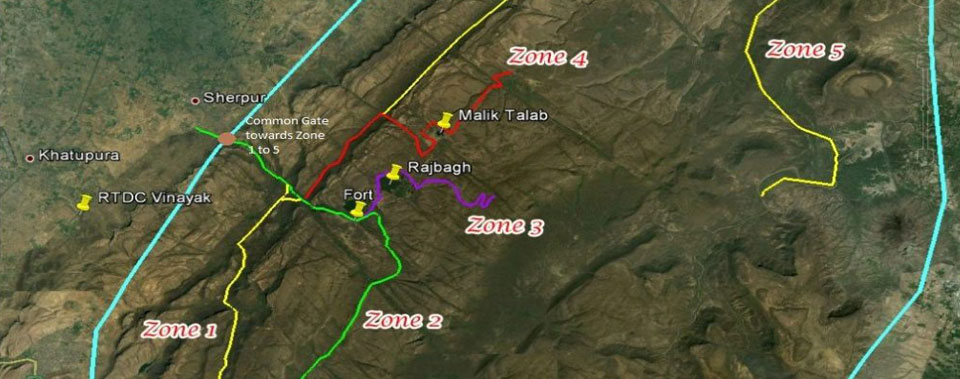The Ranthambore forest is a large landscape of dry deciduous Anogeissus Pendula forest which is left intact in India. Earlier, there was many such forests exist along the foothills of the Aravali and Vindhya mountain range, but with time, many forests degraded and destroyed by the human interference. For now, the plateau of the Ranthambore forest is the only such a big expanse of dry deciduous Anogeissus pendula forest exists in India. Situated on the plateau that lies between the hills of the Aravali and Vindhya Range, the forest is endowed with the amazing natural bliss in the dry and deserted region of Rajasthan state. The rich diversity of the flora and fauna in the Ranthambore National Park is the prime reason to attract millions of tourists every year.

Among such a large variety of flora and fauna, the Panthera Tigris or the royal Bengal tiger is the premier species in the Ranthambore Park. The park is the only region in the westernmost part of India where tigers exist. However, the growing count of the tigers in this forest has paved the way for other national park and sanctuaries in the Rajasthan to host tiger and be the natural habitat of this wild endangered animal. Many tigers and cubs are relocated to the other parks to distribute the growing density of tigers in the Ranthambore forest. The forest also plays an important role in the wildlife corridor development to connect the protected forests to enhance the proper distribution of wild animals.
The Ranthambore tiger reserve is also an important watershed for the nearby regions, and it is more significant considering the low annual rainfall in the region. It is the prominent watershed of the Chambal River and many other reservoirs that surround the forest. The forest plays a crucial role in boosting the ground water of the adjacent areas and it is very significant because the ground water and reservoirs are the only sources of water in the neighboring areas due to the minimal annual rainfall.
Topography and Climate:
The landscape of the Ranthambore forest is mostly rough and craggy with low hills and steep outcrops. The hilly area of Aravali range normally has ridges on one side and the moderate slope on the other. This Aravali expanse is mostly undulating landscape except for a few small flat terrain areas and few small valleys. These valleys are the home to a wide range of wildlife species and are very rich in the natural beauty. These valleys are the favorite spot for the tigers of the forest. The narrow water streams drained in the river Banas in the northern region and in the river Chambal in the southern region of the forest. However, most of these narrow water streams are the seasonal channels except few streams flowing in the sharp ridges are permanent because the rocky layers beneath doesn't allow the water to percolate through the soil.
Both the rivers in Ranthambore, the Chambal and the Banas are having the prominent ravines in the area which holds very significant value to enhance flora and fauna in the region. Due to the sandy soil along the river banks, the ravines are created and few ravines along the Chambal River are very deep around 50 meters and long about 8 km. The landscape of the forest varies dramatically from the mild and vertical slopes to the sharp and pointed hills as the geography changes from the Vindhyas range to the Aravali range. Adding to the vintage quotient, there is a 10th century old Fort, a world heritage site, right in the middle of the forest. The whole forest has been covered with the Dhok (Anogeissus pendula), somewhere dense and somewhere sparse, along with the grasslands around the water bodies, valleys and abundant flora around the canals. The beautiful lakes are the prime attractions for the tourists in the forest. The main lakes like Padam Talao, Malik Talao and Raj Bagh Talao are very rich in aquatic vegetation which includes lotus, lilies, duckweeds, etc.
The region of the Ranthambore National Park is having the sub-tropical dry climate with mainly three seasons all round the year - summer, winter and monsoon. The summer season starts from the month of April and ends in July when monsoon starts. Monsoon stays from July to September thus the park is closed during this time. During the October month, the season changes from monsoon to winter and the winter season starts from Nov and stays till the first half of March. The month of March is the transition month for weather as it changes from winter to summer. During the summer season, the atmosphere is very hot and dry with the day temperature swings between 40 to 45 degrees Celsius during May and June and the night temperature also hangs around 30 degrees Celsius. Most of the wild animals stay around the lakes or deep in the valleys.
The rainy or the monsoon season starts from July and stays till September. During this period, the Ranthambore National Park is closed for any tourism activity. After the monsoon winds up its activity at the end of September, the weather starts to change during the October. The winter season starts from November and stays till the first half of March. In the winter season, the temperature hovers around 10 to 20 degrees Celsius. However, during December to January, the temperature goes below to the 2 degrees Celsius. The atmosphere often gets foggy during the peak winter season. The winter season is considered as the best time to visit the Ranthambore Tiger Reserve, especially the time period from October to March.
